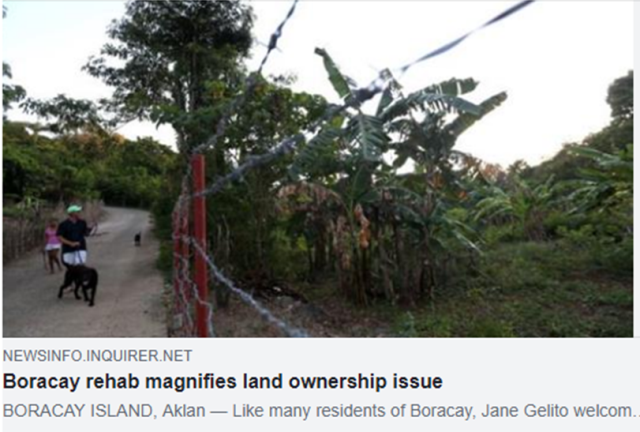Boracay: From Tourist Spot to Land Reform Area

Screengrab from the Inquirer’s Facebook page.
ALMOST TWO months since the island’s shutdown on April 26, President Rodrigo Duterte has turned the rehabilitation of Boracay into a land reform project.
Speaking to the press before his departure for South Korea on June 3, the president said: “So ibigay ko na iyan [lupa] sa mga tao for agriculture purpose. Kung hindi, kukunin ng mga may pera iyan, gawan nila iyan ng resort (I will give the land to the people for agricultural purposes. If not, the rich will take them, and they will build resorts) (“Boracay cleanup ‘not for the rich,’ says Duterte”).
Duterte had mentioned this before he ordered Boracay’s closure. In a previous monitor, CMFR cheered media for pointing out that indeed, Boracay, while known better as a tourist destination, is partly agricultural as proclaimed by former president Gloria Macapagal-Arroyo in 2006; even as the same reports noted that the prospects for farming are quite bleak. (See: “Boracay Shutdown: Where is the Master Plan?”)
Department of Agrarian Reform (DAR) Undersecretary David Erro announced on June 4 that 868 hectares of the island will be covered by the land distribution plan. Media also reported that the DAR plans to dump soil on parts of the island to make its farmland productive. (“Gov’t to dump topsoil on Boracay – DAR”).
Media coverage has reported official pronouncements on both the rehabilitation and the pursuit of a land reform program for Boracay. But little has been said about the lack of a master plan for either one and problematic issues involved in the repurposing of the Philippine’s best known tourist destination.
Monitor reviewed primetime newscasts (ABS-CBN 2’s TV Patrol, GMA-7’s 24 Oras, TV5’s Aksyon, and CNN Philippines’ News Night) and leading broadsheets (Philippine Daily Inquirer, The Philippine Star and Manila Bulletin) from May 30 to June 11.
Cheer
CMFR cheers two exceptional reports.
The Philippine Daily Inquirer featured a two-part report by Nestor Burgos Jr. who questioned how land reform would work on the island and highlights the questions about property and land titles in the island
In “Boracay rehab magnifies land ownership issue,” Burgos recalled the policy changes in relation to land titling. Former President Ferdinand Marcos declared Boracay as a tourist zone and marine reserve. Residents of Boracay filed for a declaratory relief at the Kalibo Regional Trial Court which it granted in 1999. Arroyo, however, declared 60.94 per cent of untitled land as alienable and disposable and the rest as forestland and protected areas.
With Duterte intent on pursuing his plan to make Boracay landowners are afraid that could lose their property.
In the second part, “Boracay at Crossroads: Tourism or Land Reform,” Burgos and Jaymee T. Gamil questioned the economic feasibility of the land reform plan, amid long term land disputes and the dependence of the community on tourism. Ronald Mendoza, a geodetic engineer who led the cadastral survey of the island in 2011-2012 observed that residents would probably opt to use their property for tourism for greater profit. He added: “If this is all meant to alleviate the status of the beneficiary, there is no assurance that an agrarian reform beneficiary would use [his lot] for agriculture.”
A Glaring Contradiction
Cheers also to Rappler for capturing the problematic inconsistencies in the president’s policy statements about land reform and for research on rules about the sale of agricultural land.
The report “Boracay natives can sell land to big firms if they want – Duterte,” took note of what the president said on June 12: “Ibigay ko doon sa mga natives so by the time na mag negosyo na and the big business would go in, hawak na nila ang titulo at puwede na nilang ipagbili. Ang consolation ko is makahawak sila ng pera na malaki.” – pointing out how this contradicted his earlier statement of giving the land for agricultural purposes because if not, the rich will take them.
Rappler also examined the rules of selling agricultural land, highlighting Article II, Section 3 of DAR’s Administrative Order No. 6 series of 2016, which states: “As a general rule, the transfer of ownership of all agricultural lands to a private person whose total ownership of agricultural lands after the transaction shall exceed five (5) hectares is prohibited. In addition, no Awarded Land may be transferred during the holding period.”
Other notable reports:
“Boracay’s Ati folk unsure of farming,” Philippine Daily Inquirer (June 7)
“Duterte’s plan to turn Boracay into land reform area gets mixed reactions,” The World Tonight (June 14)
“Eksperto, may babala sa planong land reform sa Boracay,” Bandila (June 19)
Leave a Reply